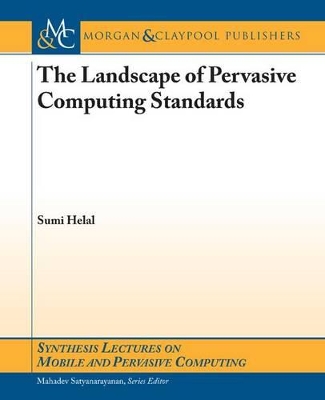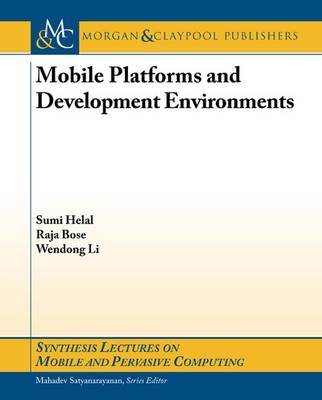Synthesis Lectures on Mobile & Pervasive Computing
2 total works
This lecture presents a first compendium of established and emerging standards in pervasive computing systems. The lecture explains the role of each of the covered standards and explains the relationship and interplay among them. Hopefully, the lecture will help piece together the various standards into a sensible and clear landscape. The lecture is a digest, reorganization, and a compilation of several short articles that have been published in the "Standards and Emerging Technologies" department of the IEEE Pervasive Computing magazine. The articles have been edited and shortened or expanded to provide the necessary focus and uniform coverage depth.
There are more standards and common practices in pervasive systems than the lecture could cover. However, systems perspective and programmability of pervasive spaces, which are the main foci of the lecture, set the scope and determined which standards should be included. The lecture explains what it means to program a pervasive space and introduces the new requirements brought about by pervasive computing. Among the standards the lecture covers are sensors and device standards, service-oriented device standards, service discovery and delivery standards, service gateway standards, and standards for universal interactions with pervasive spaces. In addition, the emerging sensor platform and domestic robots technologies are covered and their essential new roles explained. The lecture also briefly covers a set of standards that represents an ecosystem for the emerging pervasive healthcare industry.
Audiences who may benefit from this lecture include (1) academic and industrial researchers working on sensor-based, pervasive, or ubiquitous computing R&D ; (2) system integrator consultants and firms, especially those concerned with integrating sensors, actuators, and devices to their enterprise and business systems; (3) device, smart chips, and sensor manufacturers; (4) government agencies; (5) the healthcare IT and pervasive health industries; and (6) other industries such as logistics, manufacturing, and the emerging smart grid and environment sustainability industries.
There are more standards and common practices in pervasive systems than the lecture could cover. However, systems perspective and programmability of pervasive spaces, which are the main foci of the lecture, set the scope and determined which standards should be included. The lecture explains what it means to program a pervasive space and introduces the new requirements brought about by pervasive computing. Among the standards the lecture covers are sensors and device standards, service-oriented device standards, service discovery and delivery standards, service gateway standards, and standards for universal interactions with pervasive spaces. In addition, the emerging sensor platform and domestic robots technologies are covered and their essential new roles explained. The lecture also briefly covers a set of standards that represents an ecosystem for the emerging pervasive healthcare industry.
Audiences who may benefit from this lecture include (1) academic and industrial researchers working on sensor-based, pervasive, or ubiquitous computing R&D ; (2) system integrator consultants and firms, especially those concerned with integrating sensors, actuators, and devices to their enterprise and business systems; (3) device, smart chips, and sensor manufacturers; (4) government agencies; (5) the healthcare IT and pervasive health industries; and (6) other industries such as logistics, manufacturing, and the emerging smart grid and environment sustainability industries.
Mobile Platforms and Development Environments
by Sumi Helal, Raja Bose, and Wendong Li
Published 1 February 2012
Mobile platform development has lately become a technological war zone with extremely dynamic and fluid movement, especially in the smart phone and tablet market space. This Synthesis lecture is a guide to the latest developments of the key mobile platforms that are shaping the mobile platform industry. The book covers the three currently dominant native platforms -- iOS, Android and Windows Phone -- along with the device-agnostic HTML5 mobile web platform. The lecture also covers location-based services (LBS) which can be considered as a platform in its own right. The lecture utilizes a sample application (TwitterSearch) that the authors show programmed on each of the platforms.
Audiences who may benefit from this lecture include: (1) undergraduate and graduate students taking mobile computing classes or self-learning the mobile platform programmability road map; (2) academic and industrial researchers working on mobile computing R&D projects; (3) mobile app developers for a specific platform who may be curious about other platforms; (4) system integrator consultants and firms concerned with mobilizing businesses and enterprise apps; and (5) industries including health care, logistics, mobile workforce management, mobile commerce and payment systems and mobile search and advertisement.
Audiences who may benefit from this lecture include: (1) undergraduate and graduate students taking mobile computing classes or self-learning the mobile platform programmability road map; (2) academic and industrial researchers working on mobile computing R&D projects; (3) mobile app developers for a specific platform who may be curious about other platforms; (4) system integrator consultants and firms concerned with mobilizing businesses and enterprise apps; and (5) industries including health care, logistics, mobile workforce management, mobile commerce and payment systems and mobile search and advertisement.

